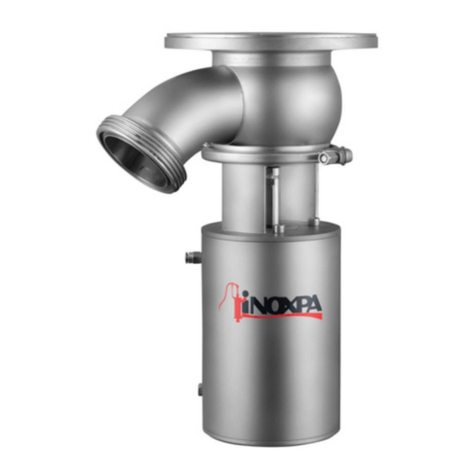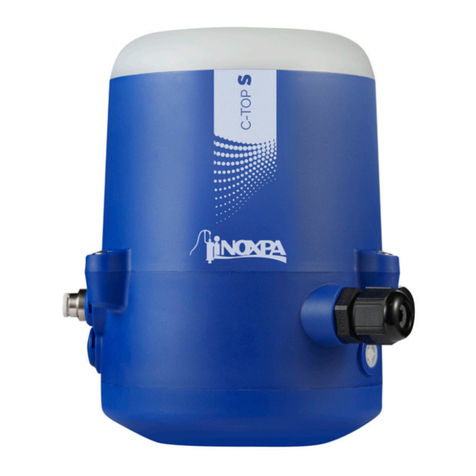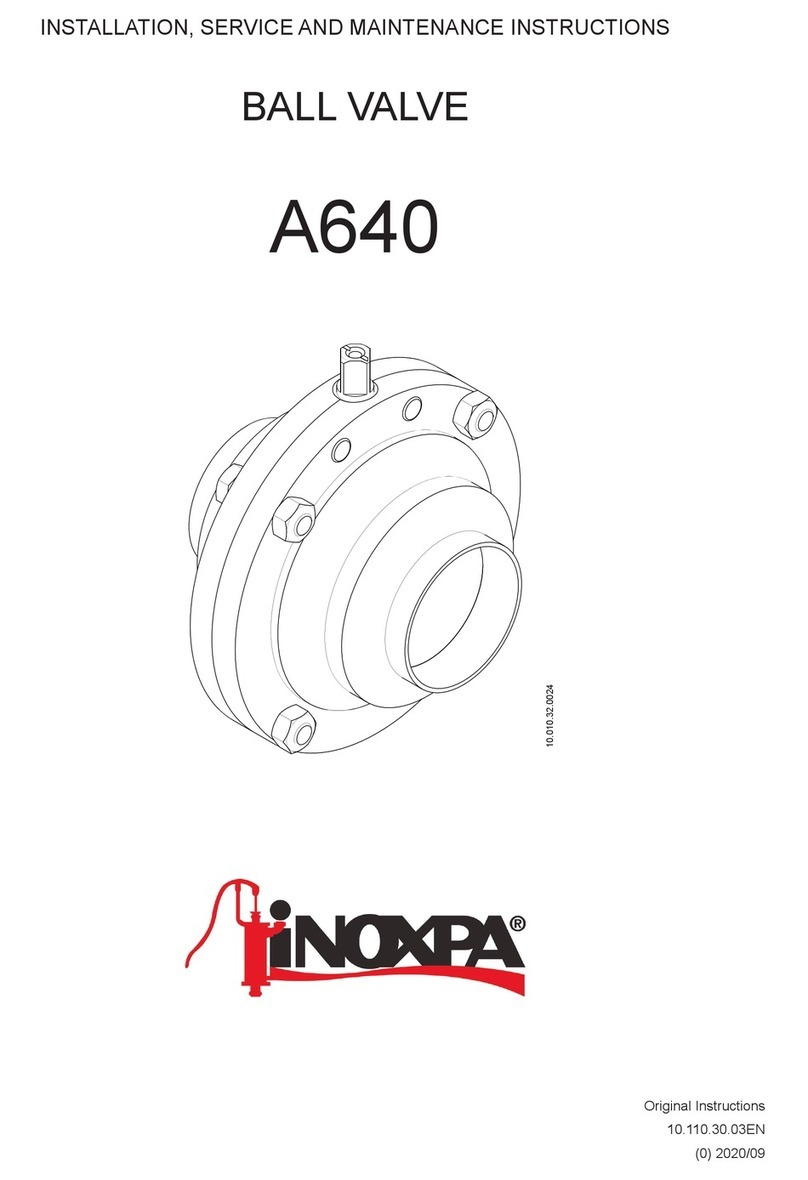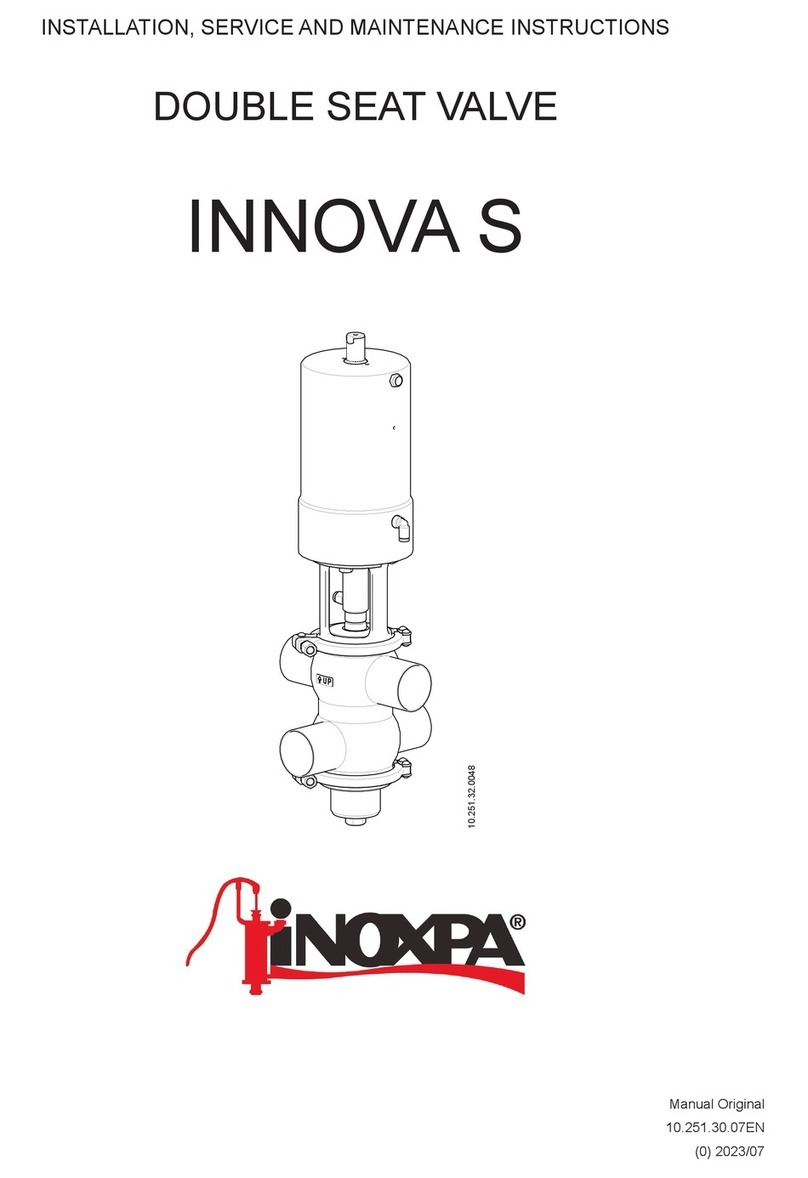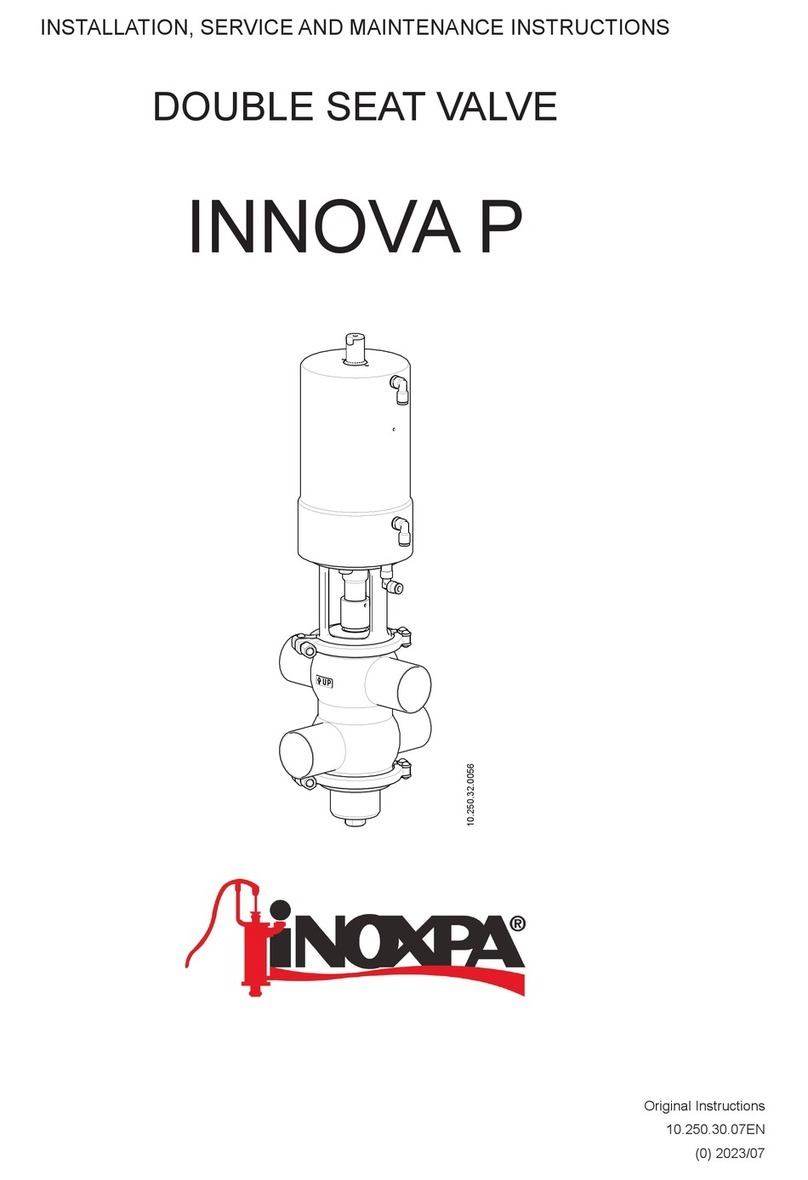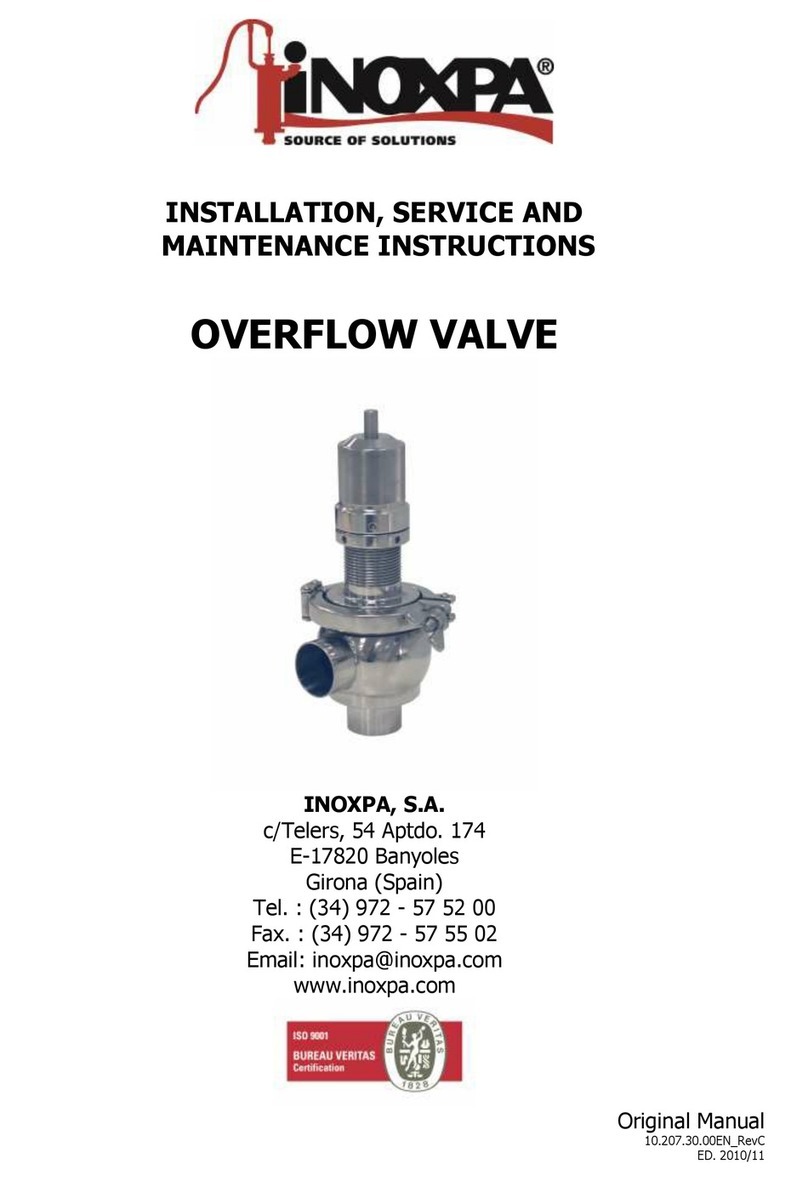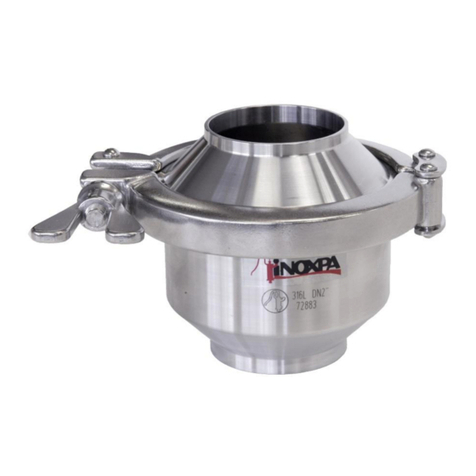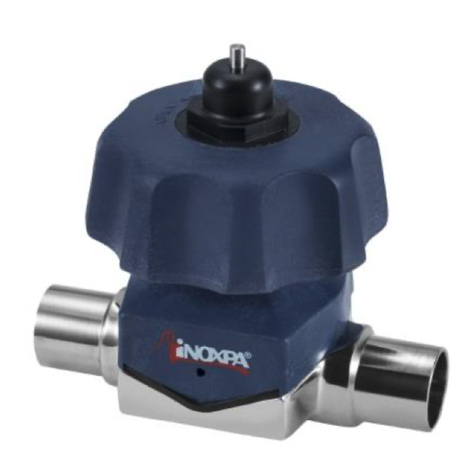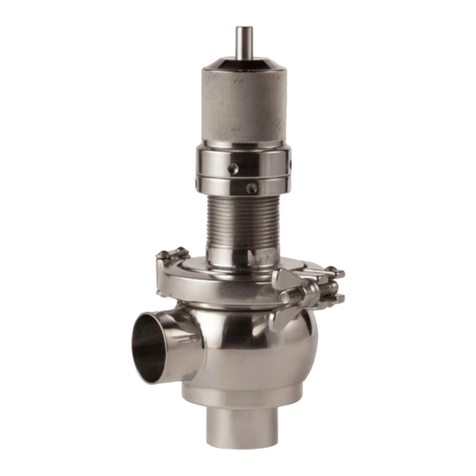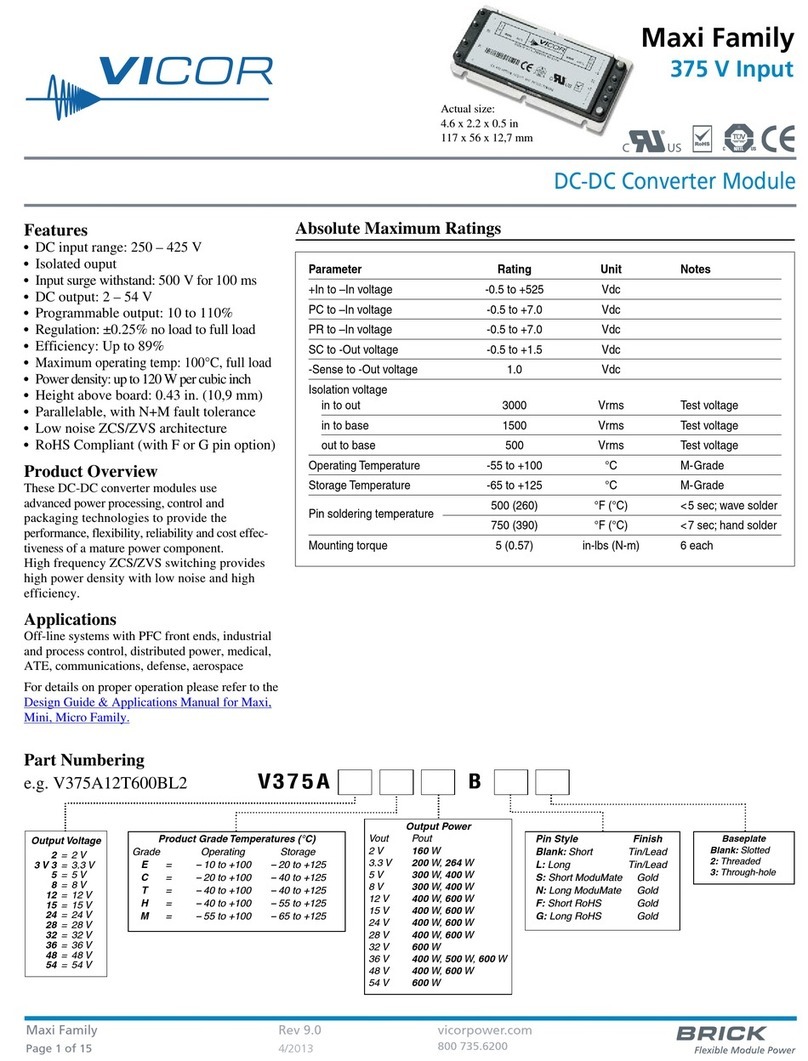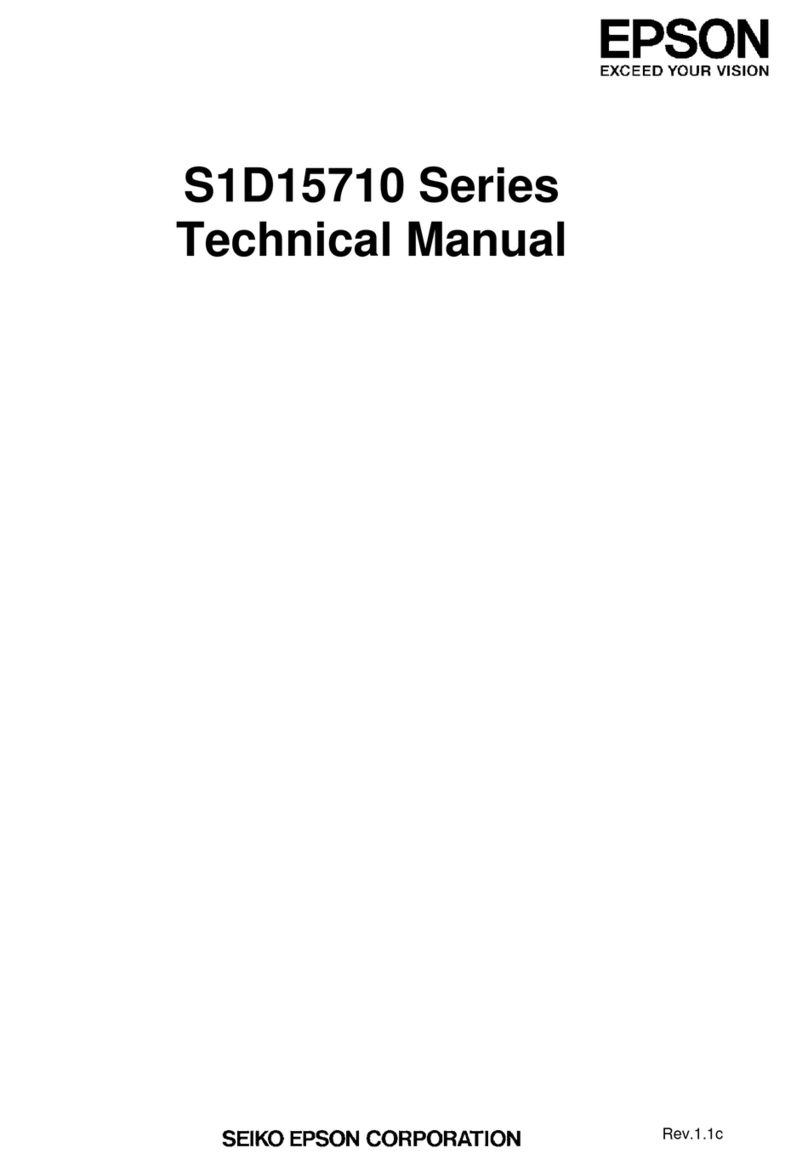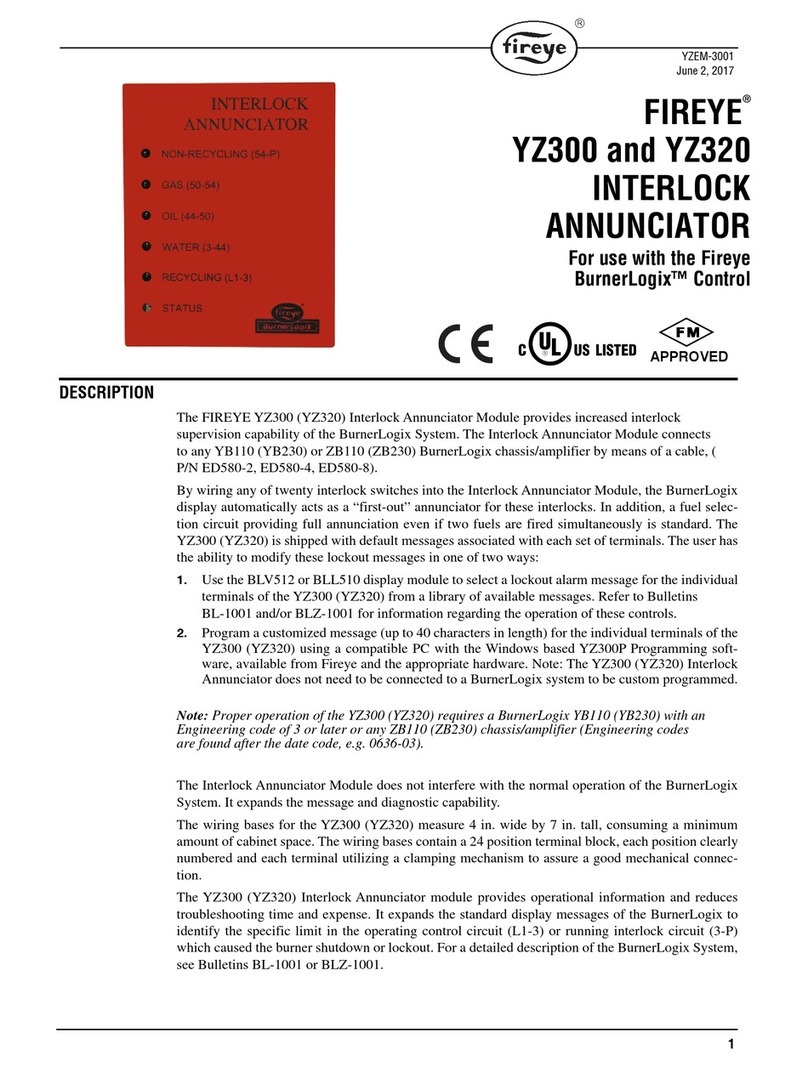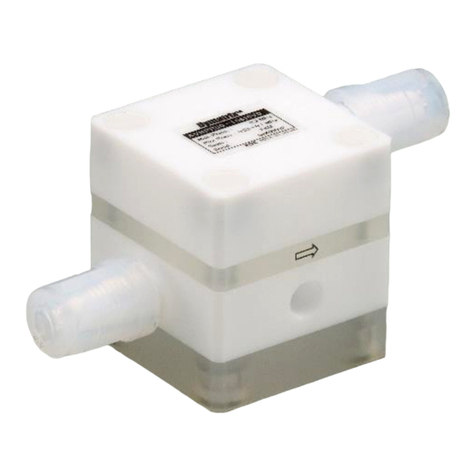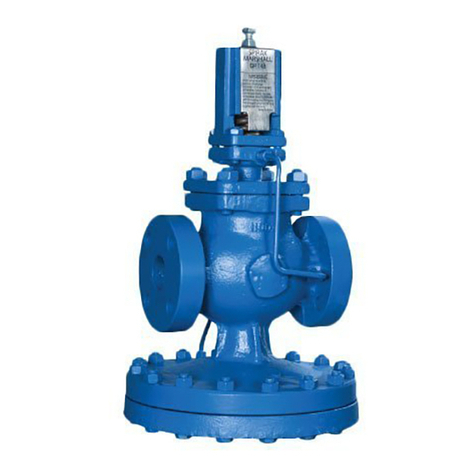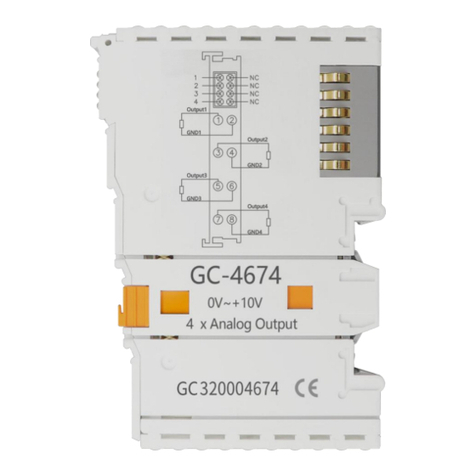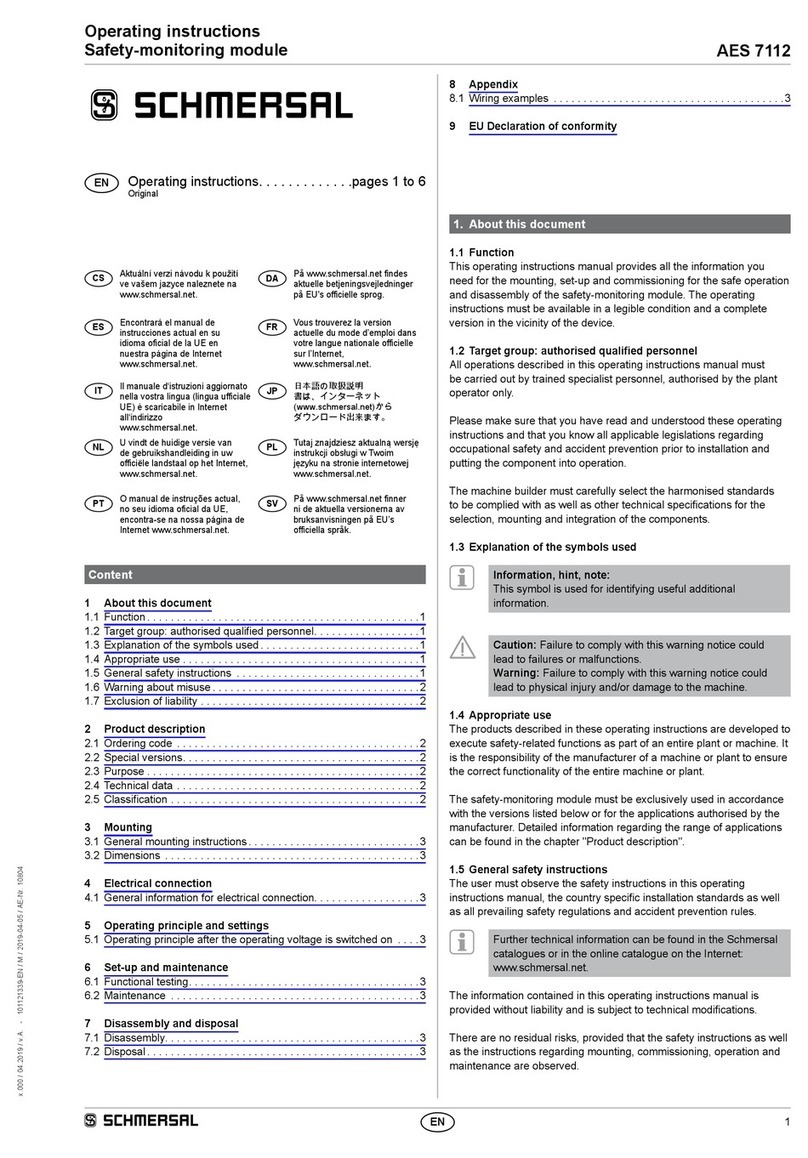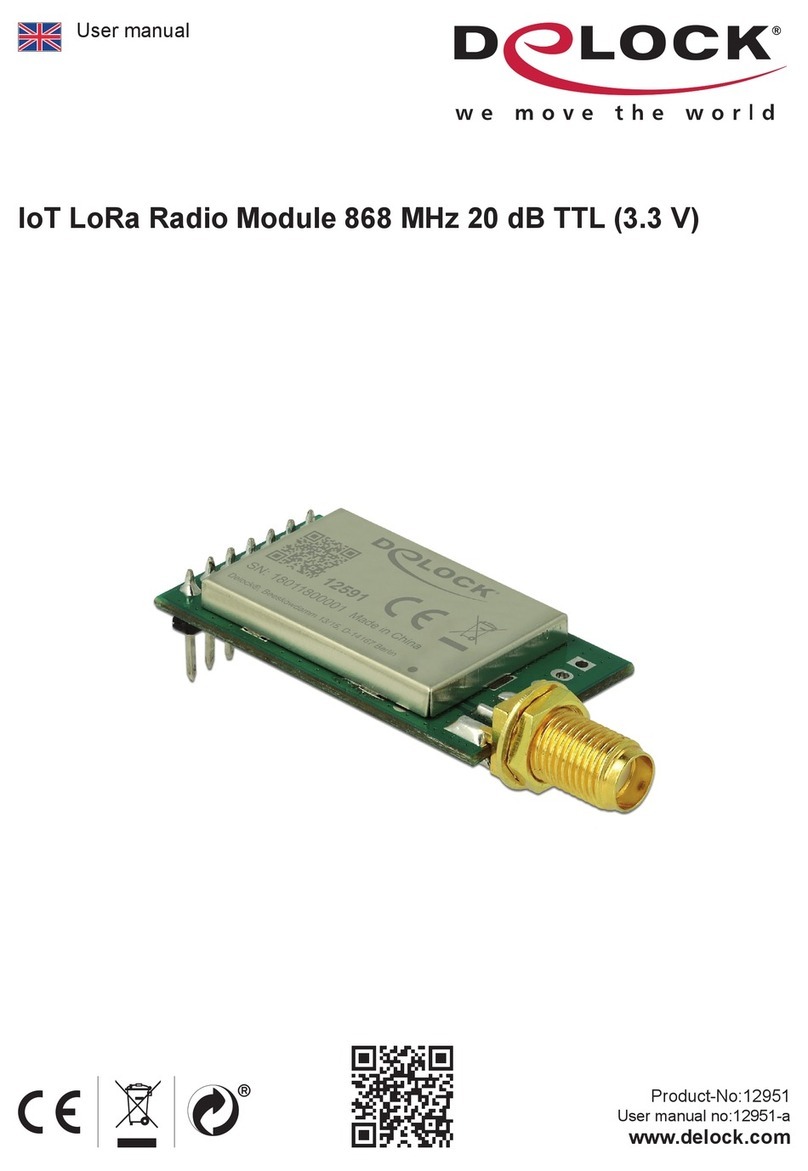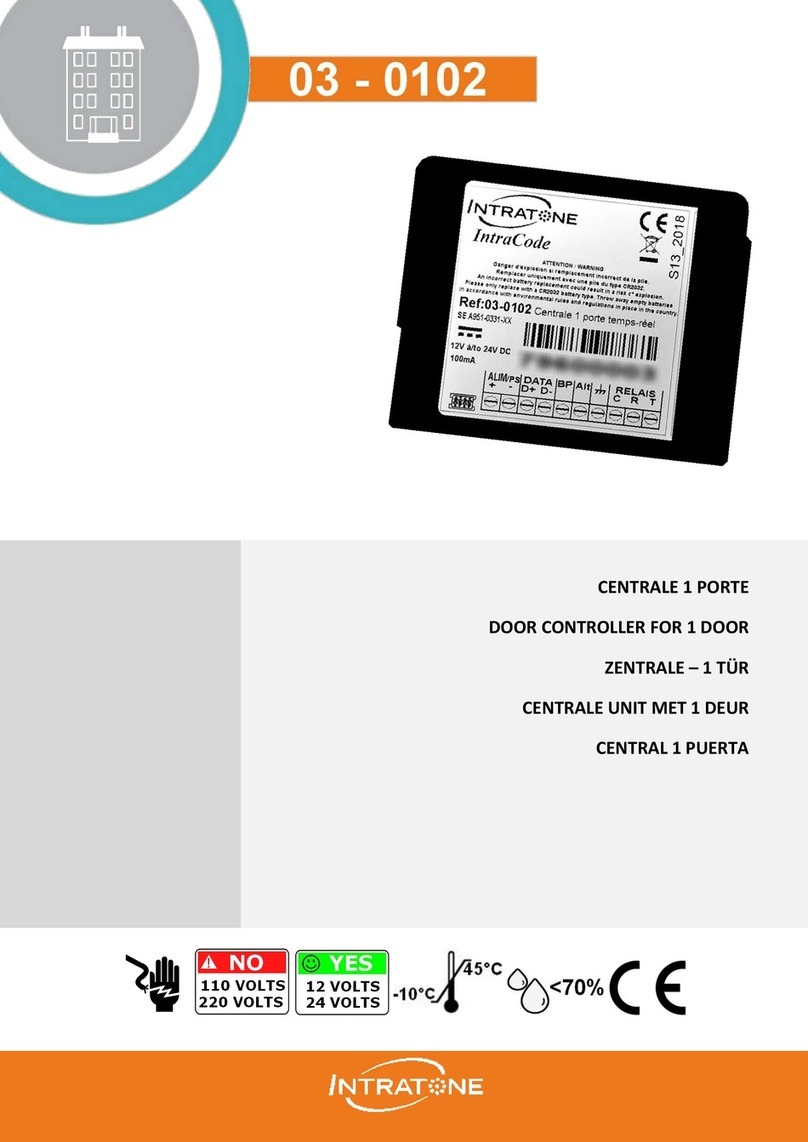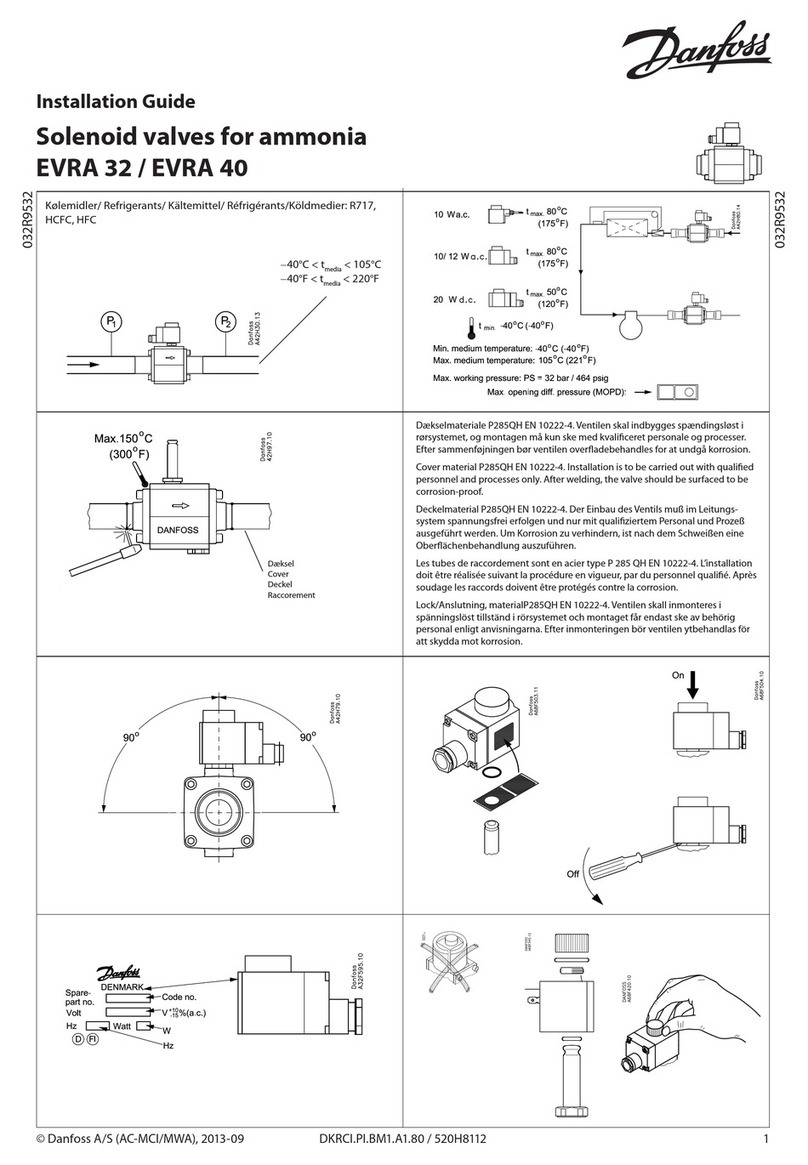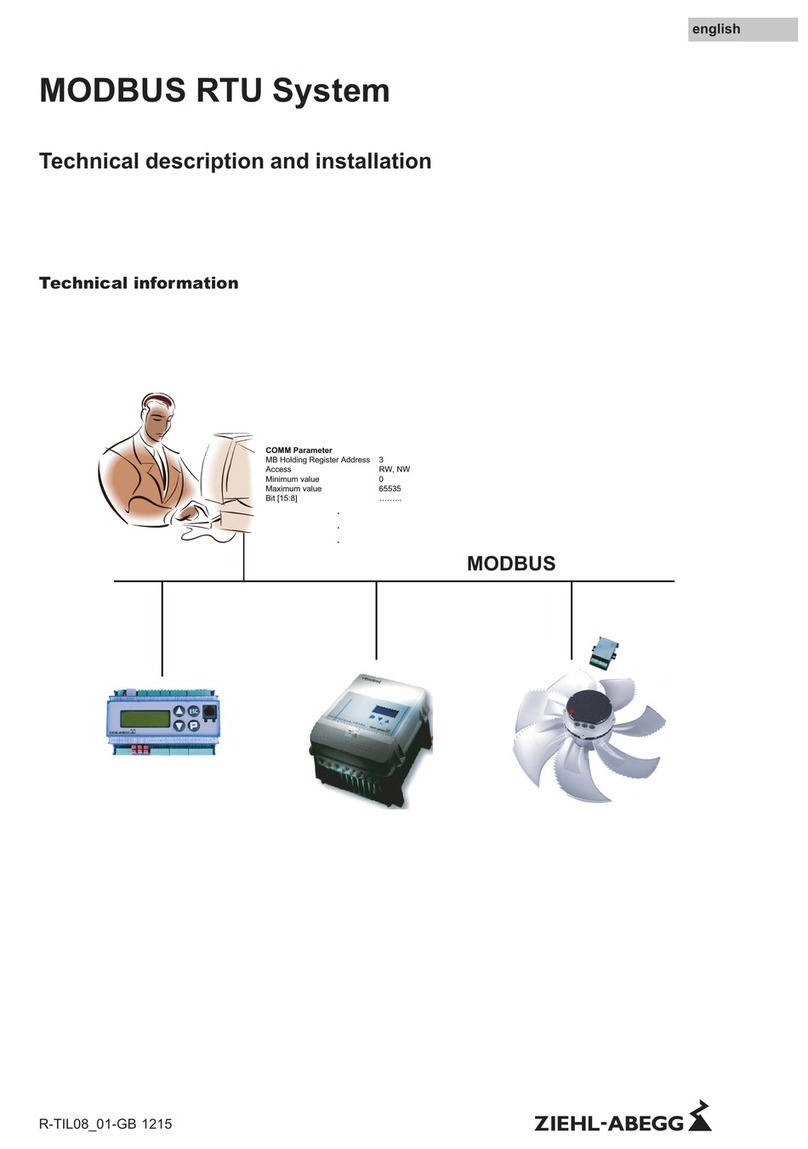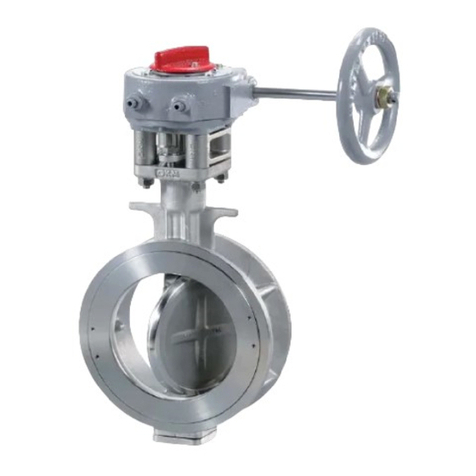INOXPA OVERFLOW VALVE Manual

OVERFLOW VALVE
74700
Original Instructions
10.207.30.07EN
(0) 2023/11
INSTALLATION, SERVICE AND MAINTENANCE INSTRUCTIONS
10.207.32.0012

E C D e c l a r a t i o n o f C o n f o r m i t y
Model:
INOXPA S.A.U.
Telers, 60
17820 - Banyoles (Spain)
hereby declare under our sole responsibility that the
Type:
Serial number:
OVERFLOW VALVE
74700
Technical Oce Manager
15th April 2023
10.207.30.04EN
(A) 2023/04
Document:
Revision:
Machine: VALVE
David Reyero Brunet
fullls all the relevant provisions of the following directive:
Machinery Directive 2006/42/EC
Pressure Equipment Directive 2014/68/EU1
Regulation (EC) nº 1935/2004
Regulation (EC) nº 2023/2006
and with the following harmonized standards and/or regulations:
The technical le has been prepared by the signer of this document.
Size: DN 25 - DN 80 / OD 1’’ - OD 3’’
IXXXXXXXXX to IXXXXXXXXX
XXXXXXXXXIINXXX to XXXXXXXXXIINXXX
1
DN≤25 Designed and manufactured in accordance with the sound engineering practice
DN>25 Class I equipment. Conformity assessment procedure used: Module A
EN ISO 12100:2010, EN ISO 14159:2008, EN 1672-2:2005+A1:2009,
EN 13732-1:2008, EN 12266-1:2012, EN 19:2016.

D e c l a r a t i o n o f C o n f o r m i t y
INOXPA S.A.U.
Telers, 60
17820 - Banyoles (Spain)
hereby declare under our sole responsibility that the
Model: OVERFLOW VALVE
Type: 74700
Technical Oce Manager
15th April 2023
10.207.30.05EN
(A) 2023/04
Document:
Revision:
Machine: VALVE
David Reyero Brunet
Size: DN 25 - DN 80 / OD 1’’ - OD 3’’
Serial number: IXXXXXXXXX to IXXXXXXXXX
XXXXXXXXXIINXXX to XXXXXXXXXIINXXX
fulls all the relevant provisions of these regulations:
and with the following designated standards:
The technical le has been prepared by the signer of this document.
Supply of Machinery (Safety) Regulations 2008
Pressure Equipment (Safety) Regulations 20161
1
DN≤25 Designed and manufactured in accordance with the sound engineering practice
DN>25 Class I equipment. Conformity assessment procedure used: Module A
EN ISO 12100:2010, EN ISO 14159:2008, EN 1672-2:2005+A1:2009,
EN 13732-1:2008, EN 12266-1:2012, EN 19:2016.

1. Table of Contents
1. Table of Contents
2. Generalities
2.1. Instructions manual........................................................................................................................................... 5
2.2. Compliance with the instructions.................................................................................................................. 5
2.3. Warranty ............................................................................................................................................................... 5
3. Safety
3.1. Warning symbols................................................................................................................................................ 6
3.2. General safety instructions............................................................................................................................. 6
4. General Information
4.1. Description ........................................................................................................................................................... 7
4.2.Application............................................................................................................................................................ 7
5. Installation
5.1. Reception of the valve...................................................................................................................................... 8
5.2.Transport and storage...................................................................................................................................... 8
5.3. Identication of the valve................................................................................................................................. 8
5.4. Location .............................................................................................................................................................. 10
5.5. Direction of ow................................................................................................................................................ 10
5.6. General installation ......................................................................................................................................... 10
5.7. Checking and review .......................................................................................................................................11
5.8. Welding ................................................................................................................................................................11
6. Start-up
6.1. Calibration of the valve .................................................................................................................................. 12
7. Operating problems
8. Maintenance
8.1. General considerations.................................................................................................................................. 14
8.2. Maintenance...................................................................................................................................................... 14
8.3. Cleaning.............................................................................................................................................................. 15
8.4. Disassembly and assembly the valve ....................................................................................................... 17
8.5. Disassembly and assembly of the overow valve 74700................................................................... 17
8.6. Disassembly and assembly of the overow valve 74700 with handle............................................ 19
8.7. Disassembly and assembly of the overow valve 74700 with PTFE seat seal........................... 21
9. Technical Specications
9.1. Valve .................................................................................................................................................................... 22
9.2. Materials ............................................................................................................................................................. 22
9.3. Sizes available.................................................................................................................................................. 22
9.4. Weights of overow valve 74700................................................................................................................ 22
9.5. Dimensions of the overow valve 74700 ................................................................................................. 23
9.6. Dimensions of the overow valve 74700 with handle.......................................................................... 23
9.7. Exploded drawing and parts list of the overow valve 74700 ........................................................... 24
9.8. Exploded drawing and parts list of the overow valve 74700 with handle.................................... 25
9.9. Exploded drawing and parts list of the overow valve 74700 PTFE seat seal............................ 26
9.10. Exploded drawing and parts list of the overow valve 74700 PTFE with handle and PTFE
seat seal ..................................................................................................................................................................... 27
INOXPA S.A.U. 10.207.30.07EN · (0) 2023/11
4

2. Generalities
2.1. INSTRUCTIONS MANUAL
This manual contains information about the reception, installation, operation, assembly and mainte-
nance of overow valve 74700.
Carefully read the instruction prior to starting the valve, familiarize yourself with the installation, ope-
ration and correct use of the valve and strictly follow the instructions. These instructions should be
kept in a safe location near the installation area.
The information published in the instruction manual is based on updated data.
INOXPA reserves the right to modify this instruction manual without prior notice.
2.2. COMPLIANCE WITH THE INSTRUCTIONS
Not following the instructions may impose a risk for the operators, the environment and the machine,
and may cause the loss of the right to claim damages.
This non-compliance may cause the following risks:
- failure of important machine/plant functions,
- failure of specic maintenance and repair procedures,
- possible electrical, mechanical and chemical hazards,
- risk to the environment due to the type of substances released.
2.3. WARRANTY
The conditions of the warranty are specied in the General Sales Condition that has been delivered
at the time of placing your order.
The machine may not undergo any modication without prior approval from the manu-
facturer.
For your safety, only use original spare parts and accessories. The usage of other parts
will relieve the manufacturer of any liability.
Changing the service conditions can only be carried out with prior written authorization
from INOXPA.
Please do not hesitate to contact us in case of doubts or if further explanations are required regar-
ding specic data (adjustments, assembly, disassembly, etc.).
The non-compliance of the prescribed indications in this manual means misuse of this gear on the
technical side and the personal safety and this, exempt INOXPA of all responsibility in case of ac-
cidents and personal injuries and/or property damage. Also, excluded from the warranty all break-
downs caused by improper use of the gear.
Generalities
5
INOXPA S.A.U. 10.207.30.07EN · (0) 2023/11

3.1. WARNING SYMBOLS
3. Safety
Safety hazard for people in general and/or equipment
ATTENTION Important instruction to prevent damage to the equipment and/or its function
3.2. GENERAL SAFETY INSTRUCTIONS
Read the instruction manual carefully before installing and starting the valve. Contact
INOXPA in case of doubt.
3.2.1. During installation
Always take into account the Technical Specications of chapter 9.
The installation and use of the valve should always be in accordance with applicable
regulations regarding health and safety.
Before starting up the valve, check that it is assembled correctly and its shaft is perfectly
aligned. Incorrect alignment and/or excessive stress during coupling can cause serious
mechanical problems in the valve.
3.2.2. During operation
Always take into account the Technical Specications of chapter 9.
NEVER exceed the specied limit values.
NEVER touch the valve and/or piping that is in contact with the uid during operation. If
the process involves hot products there is a risk of burns.
The valve contains parts that move in a linear fashion. Do not place hands or ngers in
the valve closing area. This can cause serious injury.
3.2.3. During maintenance
Always take into account the Technical Specications of chapter 9.
NEVER disassemble or remove the valve until the pipes have been emptied. Bear in
mind that the uid in the pipe may be hazardous or extremely hot. Consult the regula-
tions in eect in each country for these cases.
Release the spring tension before starting the disassembly of the valve.
Do not leave loose parts on the oor.
Safety
INOXPA S.A.U. 10.207.30.07EN · (0) 2023/11
6

4. General Information
The overow valve 74700 is a valve with a sanitary design operated by springs. It protects the facili-
ties from possible overpressures.
The valve is calibrated to a specic pressure by the pressure nut. This pressure is the safety maxi-
mum pressure to avoid damage to the facility. Under working standard conditions, the valve remains
closed. If the circuit pressure exceeds the calibrated pressure, the valve is opened, allowing the ow
to pass and reducing the pressure facility.
The valve can incorporate a handle designed to allow the valve remains partially open. Thus, during
the CIP process, the cleaning products can pass through the valve.
4.1. DESCRIPTION
4.2. APPLICATION
The overow valve 74700 is a valve used to perform bypass as a relief measure to protect lines,
pumps, accessories, tanks, etc. of the dairies, food, beverage, pharmaceutical or chemical indus-
tries.
General Information
7
INOXPA S.A.U. 10.207.30.07EN · (0) 2023/11

5.1. RECEPTION OF THE VALVE
5. Installation
INOXPA is not liable for any deterioration of the material caused by its transport or unpac-
king.
When receipt the valve, check to see whether all the parts listed on the delivery slip are present:
- complete valve
- its components if any are supplied,
- quick installation guide or instruction manual.
INOXPA inspects all its equipment before packaging. However, it cannot guarantee that the mer-
chandise arrives at the user intact.
When unpacking the valve:
- take all possible precautions against damage to the valve and its components,
- remove any possible traces of packaging from the valve or its parts,
- inspect the valve or the parts that comprise it for possible damage incurred during shipping.
5.2. TRANSPORT AND STORAGE
The buyer or user shall be liable for assembly, installation, start-up and operation of the
valve.
Take all possible precautions when transport and storage the valve to avoid damage it and its com-
ponents.
5.3. IDENTIFICATION OF THE VALVE
Each valve is inscribed with its fabrication number. Indicate de fabrication number on all documents
to refer to the valve.
Installation
INOXPA S.A.U. 10.207.30.07EN · (0) 2023/11
8

V74 0 0 - 00 06 52 050 06
Tared
03 0 - 300 kPa (0 - 3 bar)
06 0 - 600 kPa (0 - 6 bar)
10 0 - 1000 kPa (0 - 10 bar)
Size
025 DN 25, OD 1’’
032 DN 32
040 DN 40
045 OD 1½’’
050 DN 50, OD 2’’
063 OD 2½’’
065 DN 65
076 OD 3’’
080 DN 80
Seals
52 EPDM
70 PTFE/FPM
78 FPM
Material
06 1.4404 (AISI 316L)
Connection
00 welded/welded
10 male/welded
11 male/male
77 clamp/clamp
Standard pipe
0 DIN
1 OD
Type
0 standard
1 manual
Product family
V74 Overow valve 74700
Installation
9
INOXPA S.A.U. 10.207.30.07EN · (0) 2023/11

5.4. LOCATION
Place the valve leaving enough space around it to realise easily the disassembly, inspection and
review of the valve even when the valve is operating. Consult in chapter 5.8. Welding the required
minimum distances. The installation should allow that the removable parts are could remove easily.
5.6. GENERAL INSTALLATION
The overow valve 74700 is designed to be installed according to the ow direction indicated in the
following gure:
5.5. DIRECTION OF FLOW
After the location of the valve is dened, the valve can be joined to the pipe by welding the valve
housing or using ttings.
In case of joining the valve to the pipe by ttings do not forget the seals and tighten the unions pro-
perly.
The overow valve can be installed in any position although tting it upside down is not recommen-
ded.
10.207.32.0016
10.207.32.0017
Recommended Not recommended
10.207.32.0018
During installation, the valve avoids using excessive force and pay
special attention to:
- vibrations that may be produced on the facility,
- thermal dilation that the pipe may undergo when hot uids are
circulating,
- the weight that the pipe can support,
- excessive welding current.
10.207.32.0019
Installation
INOXPA S.A.U. 10.207.30.07EN · (0) 2023/11
10

5.7. CHECKING AND REVIEW
Perform the following checks before using the valve:
- check that the clamp and the regulation nut are tighted enough,
- if the valve has a handle, turn it several times to check the correct opening of the valve seat.
5.8. WELDING
Welding work should only be done by qualied persons who are trained and equipped
with the necessary equipment to perform this kind of work.
To perform the welding works:
- disassemble the valve as indicated in chapter 8.5. Disassembly and assembly of the overow
valve 74700,8.6. Disassembly and assembly of the overow valve 74700 with handle and 8.7.
Disassembly and assembly of the overow valve 74700 with PTFE seat seal.
- weld the valve body to the pipes maintaining the distance indicated in the following table,
dimension A. This will allow for disassembly of the valve, doing the subsequent reviews and
changing the necessary valve pieces like seals, bushings, etc.
10.207.32.0020
10.207.32.0021
DN A (mm)
Standard Manual
25 - 1’’ 250 325
32 260 335
40 - 1½’’ 275 345
50 - 2’’ 300 360
65 - 2½’’ 355 425
80 - 3’’ 380 445
A
A
10.207.32.0022
10.207.32.0023
- Mount the valve following the instructions indicated in chapter 8.5. Disassembly and assembly
of the overow valve 74700,8.6. Disassembly and assembly of the overow valve 74700 with
handle and 8.7. Disassembly and assembly of the overow valve 74700 with PTFE seat seal.
Installation
11
INOXPA S.A.U. 10.207.30.07EN · (0) 2023/11

6. Start-up
Read carefully the instructions in chapter 5. Installation before start-up the valve.
Before putting the valve into service the following must be taken into consideration:
- check that the piping and valve are completely free of possible traces of welding slag or other
foreign particles. Clean the system if necessary,
- check that the valve moves smoothly. If necessary, lubricate it with special grease or soapy
water,
- check for possible leaks, and make sure the pipes and their connections are sealed and do not
have any leaks,
- in the case of the manual valve, actuate the valve.
Before start-up, the persons in charge must be duly informed about how the valve works
and the safety instructions to follow. This instruction manual will be available to person-
nel at all times.
ATTENTION
Do not modify the operating parameters for which the valve has been designed without
prior written authorisation from INOXPA.
¡Burn hazard! Do not touch the valve or the pipes when hot uids are circulating or when
cleaning and/or sterilization are being carried out.
6.1. CALIBRATION OF THE VALVE
Upon request, the overow valve is shipped calibrated from the factory.
The valve calibration is performed with a ow recirculation through a bypass-type mounting. To per-
form it, it is necessary to have a pump, a gauge, a shut-o valve and the overow valve to tare and
follow the next steps:
- operate the pump with the shut-o valve in closed position. Thus, the ow will do the recircula-
tion going through the overow valve,
- loosen the lock nut and tighten the top nut of the overow valve until the gauge indicates the
whished pressure in the overow valve.
Once the valve is calibrated, it will open when the installation pressure exceeds the calibrated pres-
sure. So, the ow will recirculate to prevent the installation damage.
10.207.32.0007
Start-up
INOXPA S.A.U. 10.207.30.07EN · (0) 2023/11
12

7. Operating problems
Valve does not close
Internal leak of product (valve closed)
External leak of product
Valve does not open/close
PROBABLE CAUSES SOLUTIONS
•Dirt and/or foreign body between the shaft sleeve
and the valve body seat. - Clean the body and the seat
•The springs are not applying pressure on the
shaft stop washer. - Increase the tightening torque of the springs
•The shaft sleeve seal is worn or defective - Replace the seals
• Normal wear of the seals - Replace the seals
•
Premature
wear of the
seals
Sealing gasket worn or aected by
the product - Replace the seals with others of dierent mate-
rial and more adequate for the product
- Tighten the loosening pieces
- Clean frequently
Excessive pressure in the line
Working temperature too high
Loss of tightness (vibrations)
• Back pressure - Change the spring with a stronger one
• Body seal defective
- Replace the seals with new ones
• Shaft seal defective
• Deformation of seat seal - Replace the seat seal with another of dierent
quality if it has deteriorated prematurely
•Spring in poor condition and/or jam for the dirt - Replace or clean the spring and the shaft
•The valve does not open when the pressure
increases - Calibrated the valve
Operating problems
13
INOXPA S.A.U. 10.207.30.07EN · (0) 2023/11

8. Maintenance
This valve, just like any other machine, requires maintenance. The instructions in this chapter cover
the maintenance of the valve, the identication and replacement of the spare parts and the disas-
sembly and assembly of the valve. The instructions are aimed at maintenance personnel and those
responsible for the supply of spare parts.
Read carefully the chapter 9. Technical Specications.
Maintenance work should only be done by qualied persons who are trained and equi-
pped with the necessary equipment to perform this kind of work.
All replaced material should be duly disposed or recycled according to the directives in
eect in each area.
Make sure that the pipes are not under pressure before starting maintenance work.
8.1. GENERAL CONSIDERATIONS
8.2. MAINTENANCE
To perform maintenance properly is recommended:
- periodic inspection of the valve and its components,
- keeping an operational record of each valve writing down any problems,
- always having spare replacement seals in stock.
Pay special attention to the hazard warnings indicated in this manual during the performance of the
maintenance work.
The valve and the pipes must never be under pressure during maintenance.
¡Burn hazard! Do not touch the valve or the pipes when hot uids are circulating or when
cleaning and/or sterilization are being carried out.
8.2.1. Maintenance of the seals
REPLACING SEAL
Preventive maintenance Replace after 12 months
Maintenance after a leak Replace at the end of the process
Planned maintenance
Regularly check the absence of leaks and the smooth ope-
ration of the valve.
Keep a record of the valve’s maintenance.
Use statistics for planning inspections.
Lubrication
During assembly, apply lubricants that are suitable with the
material of which the seat seal is made. See the following
table.
The time interval between each preventive maintenance may vary in accordance with the work con-
ditions to which the valve is subject: temperature, pressure, number of operations per day, type of
cleaning solutions used, etc.
SEAL COMPONENT LUBRICANT NLGI DIN
51818 Class
FPM klübersynth UH 1 64-2403 3
EPDM / FPM PARALIQ GTE 703 3
Maintenance
INOXPA S.A.U. 10.207.30.07EN · (0) 2023/11
14

8.2.2. Storage
The valves should be stored in a closed area under the following conditions:
- temperature between 15ºC y 30ºC,
- air humidity < 60%
Storage of the equipment in the open air is NOT allowed.
8.2.3. Spare parts
To request spare parts is necessary to indicate the type of valve, the size, the fabrication number,
the position and the description of the part which can be found in chapter 9. Technical Specications.
8.3. CLEANING
The use of aggressive cleaning products such as caustic soda and nitric acid may burn
the skin.
Wear rubber gloves during all cleaning procedures.
Always wear protective goggles.
ATTENTION
Check the concentration of the cleaning solutions. An incorrect concentrations may lead
to the deterioration of the valve seals.
To remove any traces of cleaning products, ALWAYS perform a nal rinse with clean water at the end
of the cleaning process.
Clean the entire interior and exterior of the valve before starting disassembly and assem-
bly tasks.
If the valve is installed in a system with a CIP process its disassembly will not be required. EPDM is
the standard seal material that will be used for CIP cleaning, both in alkaline mediums and in acid
mediums. The material of the seal FPM is not recommended.
Two types of solutions can be used for CIP processes:
a. alkaline solution: 1% by weight of caustic soda (NaOH) a 70ºC (150ºF). To make this solution:
1 kg NaOH + 100 l H2O1= cleaning solution
2,2 l NaOH al 33% + 100 l H2O = cleaning solution
b. acid solution: 0,5% by weight of nitric acid (HNO3) a 70ºC (150ºF). To make this solution:
0,7 l HNO3 al 53% + 100 l H2O = cleaning solution
1) only use chlorine-free water to mix with the cleaning agents
8.3.1. CIP (clean-in-place) cleaning
ATTENTION
Do NOT start the equipment during the sterilization with steam.
The parts and the materials will not be damaged if the indications specied in this manual
are observed.
No cold uid can enter the equipment until the temperature of the equipment is lower
than 60°C (140°F).
Sterilization with steam is applied to all equipment including the pigging.
8.3.2. Automatic SIP (sterilization-in-place)
Maintenance
15
INOXPA S.A.U. 10.207.30.07EN · (0) 2023/11

Maximum conditions during the SIP process with steam or superheated water:
a. maximum temperature: 140ºC / 284ºF
b. maximum time: 30 min
c. cooling: sterile air or inter gas
d. materials: EPDM (the material FPM is not recommended)
Maintenance
INOXPA S.A.U. 10.207.30.07EN · (0) 2023/11
16

8.4. DISASSEMBLY AND ASSEMBLY THE VALVE
Proceed with caution. Personal injury can occur.
¡Spring with an applied load! Although the valve is at rest, there is a danger of injury in
case of loosening the clamp since the springs are tensioned, and they could throw parts
of the valve abruptly.
Release the tension of the springs before loosening the clamp.
Valve assembly and disassembly should only be done by qualied persons.
The following tools are needed in order to disassembly and assembly the valve and the drives:
- an spanner wrench to lose the locknut.
8.5. DISASSEMBLY AND ASSEMBLY OF THE OVERFLOW VALVE 74700
8.5.1. Disassembly
Release the tension of the springs before loosening the clamp.
1. If you want the same set value when you mount the valve, mark the part of the shaft (08) that pro-
jects the top nut (26C) to sign its position.
2. Lose the lock nut (26F).
3. Unscrew and disassemble the top nut of the valve (26C).
4. Remove the guide bushing (11) from the inside of the top nut (26C).
5. Unscrew and disassemble the lock nut (26F) of the valve.
6. Remove the clamp (34).
7. Remove the spring cover (12A). This will drag the spring washer (25) and the internal and external
springs.
8. Remove the springs (06) and the spring washer (25) from the spring cover (12A).
9. Pull the shaft (08) upwards to separate from the valve body (01).
10. Remove the body cover (12) from the shaft (08).
11. Remove the shaft seal (05) and the O-ring (20B) from the body cover (12).
12. Remove the elastic ring (45) from the shaft sleeve (08A).
13. Remove the shaft sleeve (08A).
14. Remove the at seal (19).
8.5.2. Assembly
1. Place the at seal (19) on the shaft (08).
2. Place the shaft sleeve (08A) on the shaft (08) situating it on top of the at seal (19) and x the
assembly with the elastic ring (45).
3. Place the shaft (08) in the valve body (01).
4. Place the O-ring (20B) in the body cover (12).
5. Place the body cover (12) on the valve body (01) passing it over the shaft (08).
6. Place the shaft seal (05) in the body cover (12).
7. Place the spring cover (12A) on the body (01) and x it with the clamp (34).
8. Place the spring washer (25) and the springs (06) in the spring cover (12A).
9. Thread the lock nut (26F) of the valve in the spring cover (12A).
10. Place the guide bushing (11) inside the top nut (26C).
11. Thread the top nut (26C) until the mark that you do on the disassembly process of the valve.
12. Thread the lock nut (26F) against the top nut (26C) to x it.
Maintenance
17
INOXPA S.A.U. 10.207.30.07EN · (0) 2023/11

3
08 34
12A
06
25
06
2
26F
26C
10.207.32.0024
4
1
11
26F
26C
01
08A
08
19
20B
05
12
10.207.32.0025
10.207.32.0026
10.207.32.0027
Maintenance
INOXPA S.A.U. 10.207.30.07EN · (0) 2023/11
18

8.6. DISASSEMBLY AND ASSEMBLY OF THE OVERFLOW VALVE 74700 WITH HANDLE
8.6.1. Disassembly
Release the tension of the springs before loosening the clamp.
1. Remove the pin (50A) from the handle (04).
2. Disassemble the handle (04) from the shaft (08).
3. If you want the same set value when you mount the valve, mark the part of the shaft (08) that pro-
jects the top nut (26C) to sign its position.
4. Disassemble the top screw (22D).
5. Lose the lock nut (26F).
6. Unscrew and disassemble the top nut (26C) of the valve.
7. Unscrew and disassemble the lock nut (26F) of the valve.
8. Remove the clamp (34).
9. Remove the spring cover (12A). This will drag the spring washer (25) and the spring (06).
10. Remove the springs (06) and the spring washer (25) from the spring cover (12A).
11. Pull the shaft (08) upwards to separate from the valve body (01).
12. Remove the body cover (12) from the shaft (08).
13. Remove the shaft seal (05) and the O-ring (20B) from the body cover (12).
14. Remove the elastic ring (45) from the shaft sleeve (08A).
15. Remove the shaft sleeve (08A).
16. Remove the at seal (19).
8.6.2. Assembly
1. Place the at seal (19) on the shaft (08).
2. Place the shaft sleeve (08A) on the shaft (08) situating it on top of the at seal (19) and x the
assembly with the elastic ring (45).
3. Place the shaft (08) in the valve body (01).
4. Place the O-ring (20B) in the body cover (12).
5. Place the body cover (12) on the valve body (01) passing it over the shaft (08).
6. Place the shaft seal (05) in the body cover (12).
7. Place the spring cover (12A) on the body (01) and x it with the clamp (34).
8. Place the spring washer (25) and the springs (06) in the spring cover (12A).
9. Thread the lock nut of the valve (26F) in the spring cover (12A).
10. Thread the top nut (26C) until the mark that you do on the disassembly process of the valve.
11. Thread the lock nut (26F) against the top nut (26C) to x it.
12. Thread and adjust the top screw (22D) to ensure the opening of the valve by the handle.
13. Place the handle (04) on the shaft (08).
14. Place the pin (50A) to x the handle (04) on the shaft (08).
Maintenance
19
INOXPA S.A.U. 10.207.30.07EN · (0) 2023/11

2
26C
26F
22D
50A
04
26C
26F
4
34
08
06
12A
25
19
45
08A
01
05
08
12
20B
1
10.207.32.0028
10.207.32.0029
10.207.32.0030
10.207.32.0031
3
Maintenance
INOXPA S.A.U. 10.207.30.07EN · (0) 2023/11
20
This manual suits for next models
1
Table of contents
Other INOXPA Control Unit manuals

INOXPA
INOXPA INNOVA F Installation and user guide

INOXPA
INOXPA BALL Installation and user guide
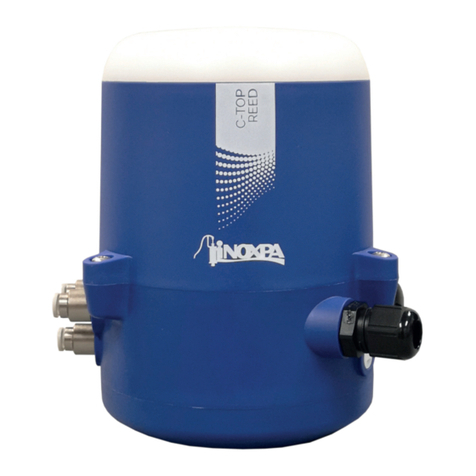
INOXPA
INOXPA C-TOP Reed Manual
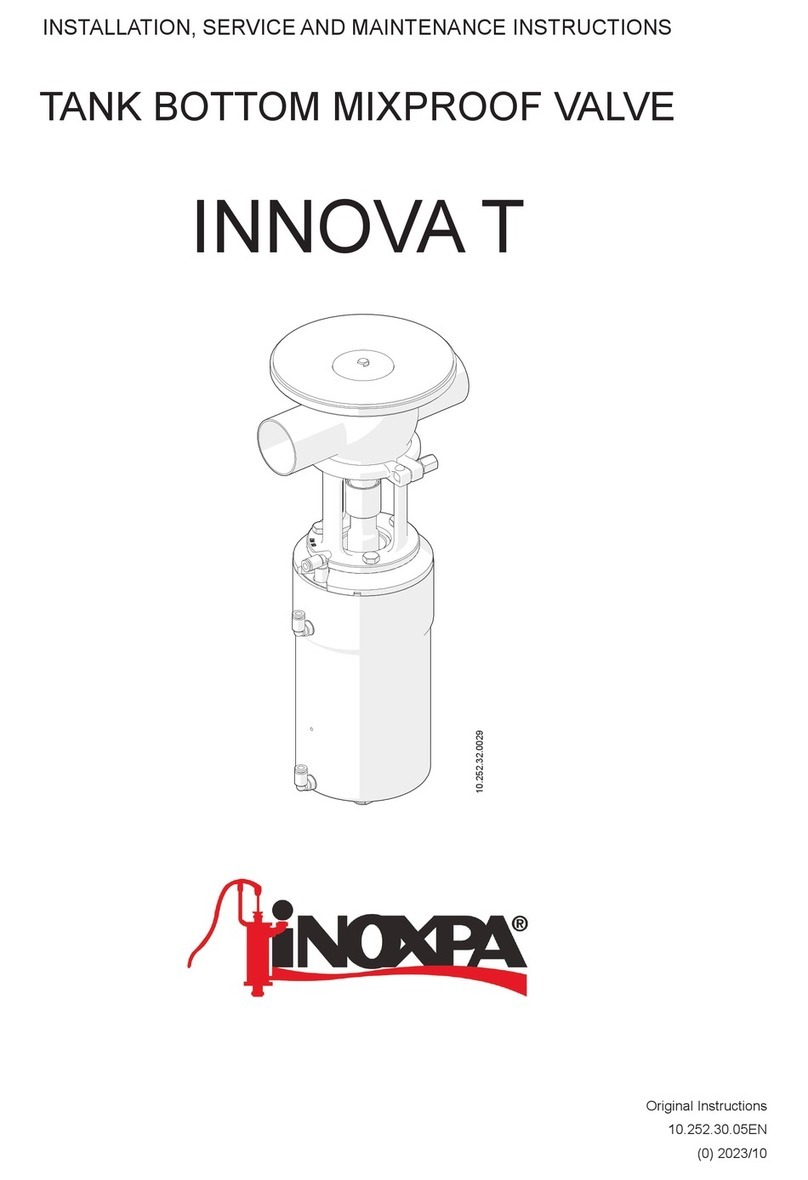
INOXPA
INOXPA INNOVA T Manual
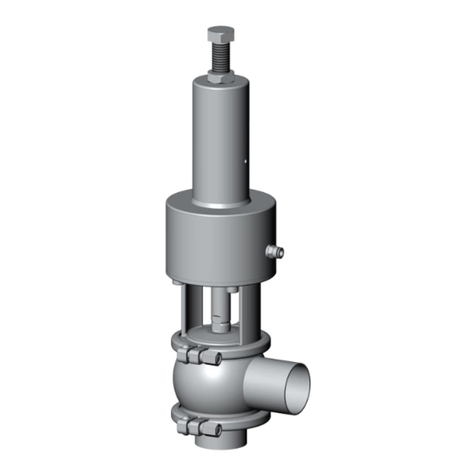
INOXPA
INOXPA INNOVA J Installation and user guide

INOXPA
INOXPA BUTTERFLY Manual
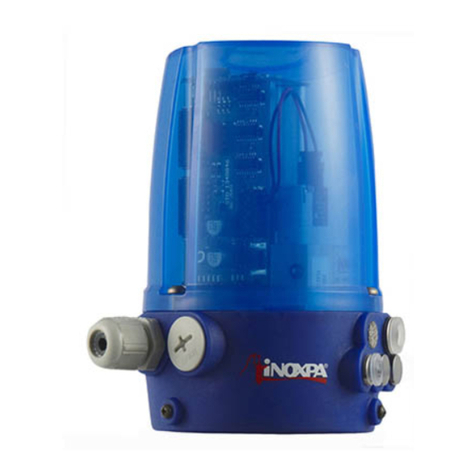
INOXPA
INOXPA C-TOP+ User manual
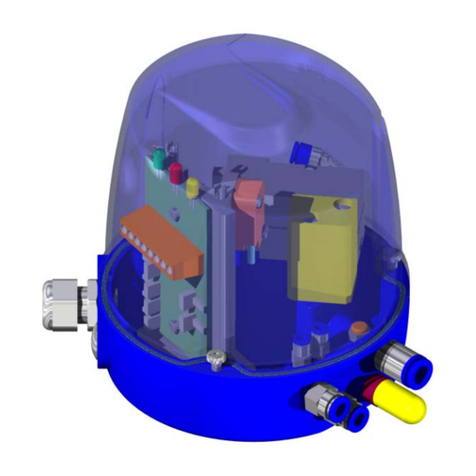
INOXPA
INOXPA C-TOP Installation and user guide

INOXPA
INOXPA INNOVA F Manual

INOXPA
INOXPA NL Manual


